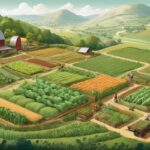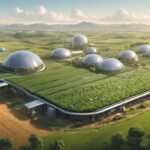Regenerative Agriculture: Healing the Land
In a world where industrial farming has often prioritized short-term yields over long-term sustainability, regenerative agriculture offers a different path—one that nurtures the soil, supports biodiversity, and restores balance to ecosystems. Rather than depleting the land, this approach seeks to heal it, fostering resilience for future generations.

What Is Regenerative Agriculture?
Regenerative agriculture is a holistic farming philosophy that goes beyond sustainability. Instead of merely maintaining the land, it actively improves soil health, enhances water retention, and sequesters carbon from the atmosphere. By working with nature rather than against it, farmers can cultivate thriving ecosystems while still producing abundant food.
Key principles of regenerative agriculture include:
- Minimal Soil Disturbance – Reducing tillage to protect soil structure and microbial life.
- Cover Cropping – Planting crops that protect and enrich the soil between harvests.
- Crop Diversity & Rotation – Avoiding monocultures to promote soil health and reduce pests.
- Integrating Livestock – Managed grazing helps cycle nutrients and stimulate plant growth.
- No Synthetic Chemicals – Avoiding pesticides and artificial fertilizers to support natural processes.
The Benefits of Healing the Land
1. Restoring Soil Health
Healthy soil is the foundation of life. Decades of conventional farming have degraded topsoil through erosion and chemical use. Regenerative practices rebuild organic matter, allowing soil to retain moisture, resist erosion, and support vibrant plant growth.
2. Capturing Carbon
One of the most promising aspects of regenerative agriculture is its ability to draw carbon dioxide from the air and store it in the soil. This not only mitigates climate change but also enhances soil fertility.
3. Supporting Biodiversity
Monocultures weaken ecosystems, while diverse farms attract pollinators, beneficial insects, and wildlife. Regenerative farms often function as mini-ecosystems, where plants, animals, and microorganisms thrive together.
4. Water Resilience
Healthy soils act like sponges, absorbing rainfall and reducing runoff. This helps prevent both droughts and floods, making farms more resilient to extreme weather.
A Quiet Revolution
Regenerative agriculture is not a new concept—indigenous communities have practiced land stewardship for millennia. Today, farmers around the world are rediscovering these principles, blending traditional wisdom with modern science.
Change happens slowly, but each farm that transitions to regenerative methods contributes to a larger healing process. Whether you’re a farmer, gardener, or consumer, supporting these practices helps create a future where agriculture doesn’t just sustain life—it revitalizes it.
How Can You Help?
- Support Regenerative Farms – Buy from local farmers who prioritize soil health.
- Grow Your Own Food – Even small gardens can incorporate regenerative techniques.
- Educate & Advocate – Share knowledge and encourage sustainable policies.
The land has an incredible capacity to heal when given the chance. Through regenerative agriculture, we can be part of that renewal—one field, one harvest, one season at a time.



